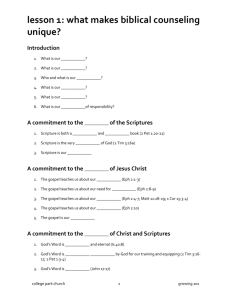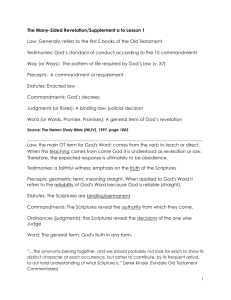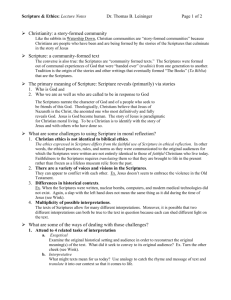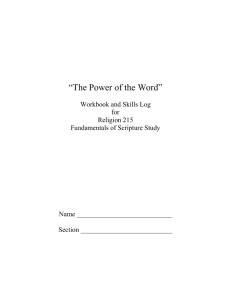CHRISTIAN TRAINING COURSE
advertisement
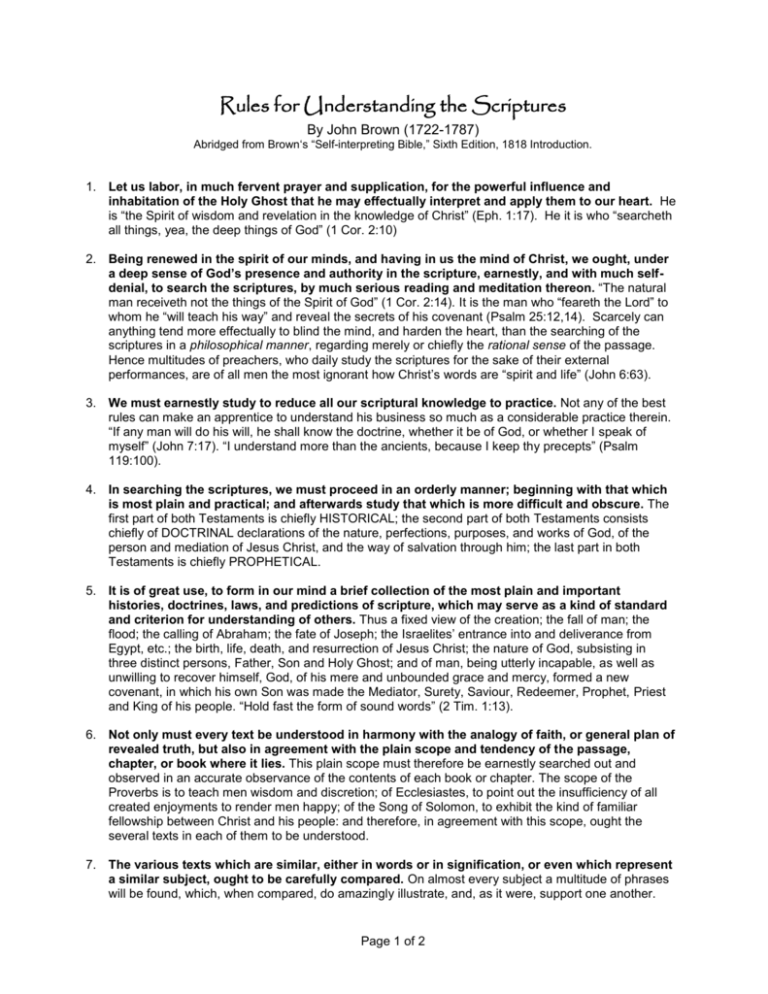
Rules for Understanding the Scriptures By John Brown (1722-1787) Abridged from Brown‘s “Self-interpreting Bible,” Sixth Edition, 1818 Introduction. 1. Let us labor, in much fervent prayer and supplication, for the powerful influence and inhabitation of the Holy Ghost that he may effectually interpret and apply them to our heart. He is “the Spirit of wisdom and revelation in the knowledge of Christ” (Eph. 1:17). He it is who “searcheth all things, yea, the deep things of God” (1 Cor. 2:10) 2. Being renewed in the spirit of our minds, and having in us the mind of Christ, we ought, under a deep sense of God’s presence and authority in the scripture, earnestly, and with much selfdenial, to search the scriptures, by much serious reading and meditation thereon. “The natural man receiveth not the things of the Spirit of God” (1 Cor. 2:14). It is the man who “feareth the Lord” to whom he “will teach his way” and reveal the secrets of his covenant (Psalm 25:12,14). Scarcely can anything tend more effectually to blind the mind, and harden the heart, than the searching of the scriptures in a philosophical manner, regarding merely or chiefly the rational sense of the passage. Hence multitudes of preachers, who daily study the scriptures for the sake of their external performances, are of all men the most ignorant how Christ’s words are “spirit and life” (John 6:63). 3. We must earnestly study to reduce all our scriptural knowledge to practice. Not any of the best rules can make an apprentice to understand his business so much as a considerable practice therein. “If any man will do his will, he shall know the doctrine, whether it be of God, or whether I speak of myself” (John 7:17). “I understand more than the ancients, because I keep thy precepts” (Psalm 119:100). 4. In searching the scriptures, we must proceed in an orderly manner; beginning with that which is most plain and practical; and afterwards study that which is more difficult and obscure. The first part of both Testaments is chiefly HISTORICAL; the second part of both Testaments consists chiefly of DOCTRINAL declarations of the nature, perfections, purposes, and works of God, of the person and mediation of Jesus Christ, and the way of salvation through him; the last part in both Testaments is chiefly PROPHETICAL. 5. It is of great use, to form in our mind a brief collection of the most plain and important histories, doctrines, laws, and predictions of scripture, which may serve as a kind of standard and criterion for understanding of others. Thus a fixed view of the creation; the fall of man; the flood; the calling of Abraham; the fate of Joseph; the Israelites’ entrance into and deliverance from Egypt, etc.; the birth, life, death, and resurrection of Jesus Christ; the nature of God, subsisting in three distinct persons, Father, Son and Holy Ghost; and of man, being utterly incapable, as well as unwilling to recover himself, God, of his mere and unbounded grace and mercy, formed a new covenant, in which his own Son was made the Mediator, Surety, Saviour, Redeemer, Prophet, Priest and King of his people. “Hold fast the form of sound words” (2 Tim. 1:13). 6. Not only must every text be understood in harmony with the analogy of faith, or general plan of revealed truth, but also in agreement with the plain scope and tendency of the passage, chapter, or book where it lies. This plain scope must therefore be earnestly searched out and observed in an accurate observance of the contents of each book or chapter. The scope of the Proverbs is to teach men wisdom and discretion; of Ecclesiastes, to point out the insufficiency of all created enjoyments to render men happy; of the Song of Solomon, to exhibit the kind of familiar fellowship between Christ and his people: and therefore, in agreement with this scope, ought the several texts in each of them to be understood. 7. The various texts which are similar, either in words or in signification, or even which represent a similar subject, ought to be carefully compared. On almost every subject a multitude of phrases will be found, which, when compared, do amazingly illustrate, and, as it were, support one another. Page 1 of 2 The truth which is more darkly represented in one passage is represented more clearly in others. And while we are thus occupied in comparing the several texts, we may humbly expect that the Holy Ghost will illuminate all with his glory, and apply all to the heart. 8. We ought never to content ourselves with a general view of any text, or of the words of it, abstractly considered; but should search out what is therein chiefly and emphatically intended by the Spirit of God as it stands in such a particular connection – thus thousands of unexpected beauties will appear to our view. Never are the oracles or truths of God seen in their real and manifold glory but when they are viewed in their proper connections. Nay, never are the oracles of God rightly received, but when viewed in their proper connection with Jesus Christ, as the author, matter, and end of them. 9. Christ Jesus being the great subject and end of scripture revelation, we ought everywhere to search if we can find him. The scriptures testify of him (John 5:39). “To him gave all the prophets witness” (Acts 10:43). Scripture history does but exhibit men’s need of Christ, and God’s preparation of the world for him. 10. As to the infinite mind of the Holy Ghost, every subject and every event are at once perfectly in view, his words in scripture ought always to be understood in the fullest latitude of signification that the analogy of faith and of the context can admit. Historical hints must be understood as relating to everything similar preceding the date, unless the context restrict them. Figures relating to the church, as in the Song of Solomon, etc., and manifold promises relating to it, ought to be applied to it as the visible mystical body of Christ, and also to every particular member of it. 11. The language of scripture, especially in the poetical and predictory parts, abounding with figures, it is necessary to have the knowledge of the principal of these fixed in our mind. The most remarkable figures of scripture language are: (1) the name of one thing is given to another; (2) more universal terms are more used for more restricted ones, as “all” for many, all kinds, some of every sort; (3) the expression appears to mean much less or much more than is really meant; (4) expressions being uttered with a derisive air, have a signification directly contrary to their natural meaning (2 Sam. 6:20; 1 Kings 18:27; Matt. 26:25); (5) no figure more abounds in scripture than metaphor, by which names, qualities, or actions, proper to one person or thing, are attributed to another, because of some likeness between them. 12. Where scriptures at first seem to contradict one another, we must, by a serious consideration of them, labor to discover their harmony. But, if we should not be able to reconcile them, we ought not to pronounce them irreconcilable, but rather attribute a deficiency to our own understanding. There can be no real contradiction. But, where there seems to be one, either (1) the same terms are used in a different sense in the different texts, or (2) the seemingly opposite texts really treat of different subjects, or (3) in the seemingly opposite texts the same subject is considered in different parts or respects, or (4) the seemingly opposite texts respect different times and places. “We must humbly adore what we cannot comprehend.” - George Whitefield in a letter to Wesley, 1740 Page 2 of 2


